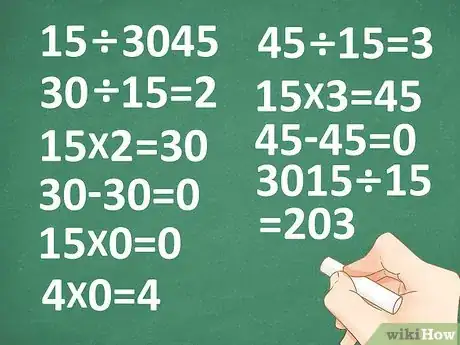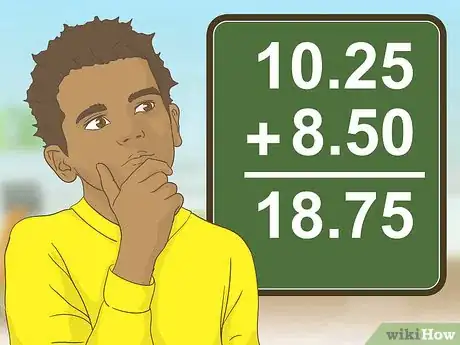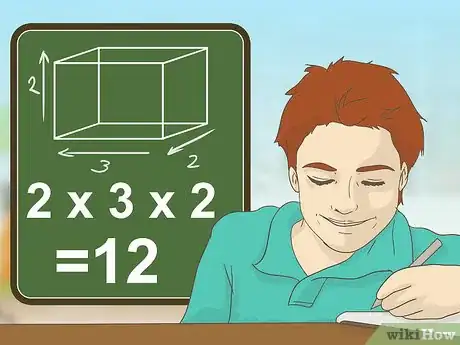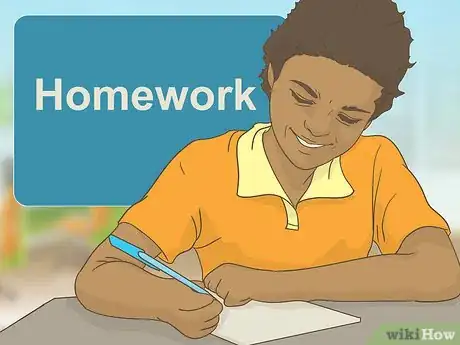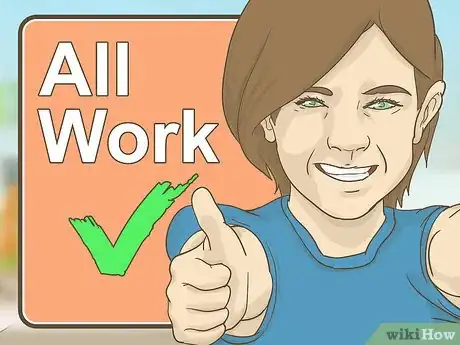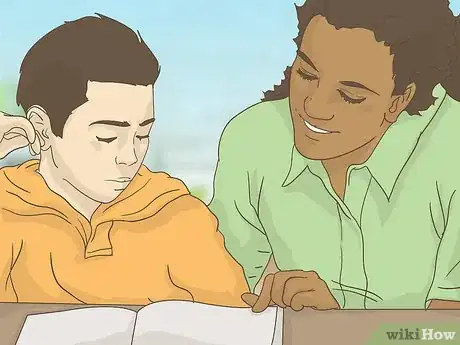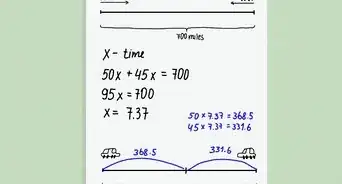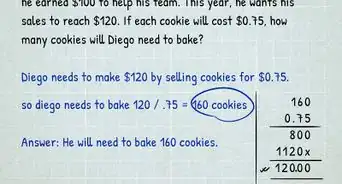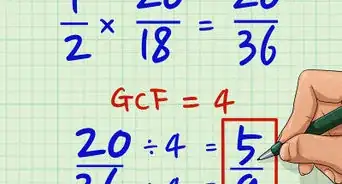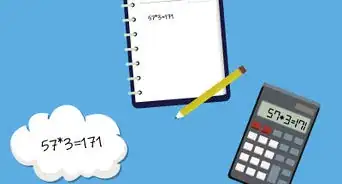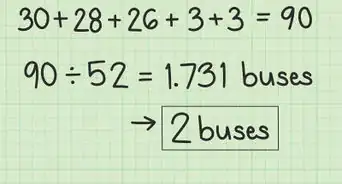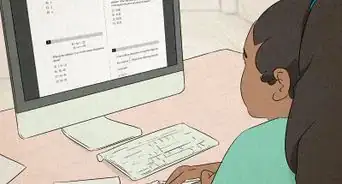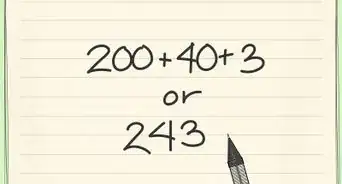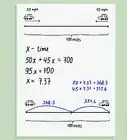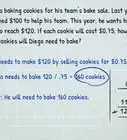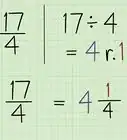This article was co-authored by Daron Cam. Daron Cam is an Academic Tutor and the Founder of Bay Area Tutors, Inc., a San Francisco Bay Area-based tutoring service that provides tutoring in mathematics, science, and overall academic confidence building. Daron has over eight years of teaching math in classrooms and over nine years of one-on-one tutoring experience. He teaches all levels of math including calculus, pre-algebra, algebra I, geometry, and SAT/ACT math prep. Daron holds a BA from the University of California, Berkeley and a math teaching credential from St. Mary's College.
There are 14 references cited in this article, which can be found at the bottom of the page.
This article has been viewed 28,568 times.
In fifth grade math, you build on what you learned in third and fourth grade. If you kept up in fourth grade math, you will probably do well in fifth grade math. Even if you struggled in fourth grade, there are ways you can catch up. You can start by learning about the big ideas in fifth grade. These ideas include working with fractions with unlike denominators, dividing by two-digit numbers, working with decimals, and finding the volume of a shape.[1] By learning these skills, as well as keeping math fun and staying organized, you can easily pass fifth grade math.
Steps
Learning the Big Ideas (Common Core)
-
1Learn how to add and subtract fractions with unlike denominators. The denominator is the number below the fraction bar. Before, you added and subtracted fractions with like denominators. Now, the denominator will be different, so you have to follow extra steps. For example, if you are adding :
- Think of the multiples of each denominator.
For the first fraction, some multiples of 2 are 2, 4, 6, 8, and 10.
For the second fraction, some multiples of 4 are 4, 8, 12. - Find the smallest multiple each denominator has in common. In this case, the smallest multiple is 4.
- Rewrite one or both fractions as equivalent fractions, so that they have the same denominator. Use the smallest common multiple. In this case, 4. For the first fraction, , so you can rewrite the problem as .
- Add the numerators. Keep the common denominator: .
- Think of the multiples of each denominator.
-
2Learn how to divide a fraction by a whole number. To do this, you first multiply the denominator by the whole number. This becomes your new denominator. Then, you just keep the same numerator.[2]
- For example, to divide , you would find .
Advertisement -
3Learn how to divide by a two-digit number. You do this the same way you divide by a single digit number, except that instead of dividing into the first digit under the division sign, you divide into the first two digits under the division sign.[3] To remember the steps of long division, use the phrase “Does McDonald’s Sell Cheese Burgers?” This will help you remember to Divide, Multiply, Subtract, Check, and Bring down.[4]
- For example, to divide , your first step is to divide 15 into 30.
Since , you would write a 2 above the 0.
Next, multiply .
Subtract .
Bring down the 4.
Since you can’t divide 15 into 4, place a 0 above the 4.
Multiply .
Subtract .
Bring down the 5.
Divide . Write the 3 above the 5.
Multiply .
Subtract . So, , with no remainder.
- For example, to divide , your first step is to divide 15 into 30.
-
4Learn how to add and subtract decimals. You do this the same way you add and subtract whole numbers. The difference is that you have to make sure that the decimal points are lined up on top of each other. You also have to add extra zeros if one number has more digits than the other. Finally, remember to drop the decimal point down into your answer, so that it lines up with the decimal points in the number you were adding or subtracting.[5]
- For example, to add rewrite the numbers so that they are on top of each other, with the decimal points lined up.
Then, add a 0 to 8.5, so that it becomes 8.50.
Next, you can add the number like you normally would. You get 1875.
When you drop down the decimal point into your answer, you get 18.75.
- For example, to add rewrite the numbers so that they are on top of each other, with the decimal points lined up.
-
5Learn how to multiply decimals. You do this the same way you multiply whole numbers. While you are multiplying, you can ignore the decimal points. When you are done multiplying, count the number of places behind the decimal point in each factor. Add up the number of places. Then, count that same number from the right in your answer. Put your decimal point in this place.[6]
- For example, to multiply , begin by multiplying . Then, since there are 2 places behind the decimal point in 3.25, and 2 places behind the decimal point in 1.75, you would count 4 places from the right in your answer. So 56875 becomes 5.6875.
-
6Learn about the volume of a 3D shape. The volume of a shape is the space inside of the shape. Think of a box. The volume would be the space inside the box. To measure the volume, you need to think about the length, width, and height of the shape. The volume of a shape is measured in cubic units. There are two different ways to measure the volume.[7]
- You can measure the volume of a shape by counting the number of unit cubes that fit inside the shape. For example, if you have a box that is 2 cubes long, 3 cubes wide, and 1 cube high, you can fit one layer of 6 cubes inside of it. This means the volume is 6 cubic units. If the box is 2 cubes high, you can fit 2 layers of 6 cubes inside of it. So that means the volume is 12 cubic units.
- You can find the volume of shape by using a formula. A formula is like a recipe that tells you how to find something. The formula for the volume of a cube is . For the box that is 2 cubes long, 3 cubes wide, and 2 cubes high, you would multiply . So the volume is 12 cubic units.
Learning the Big Ideas (Advanced Curriculum)
-
1Write percents as fractions. Percents are basically parts of one hundred. So, means that there are 25 out of 100 parts. For numerators that are common factors of 100, this is pretty simple. So, 25% is equal to . is reduced to , as the numerator and the denominator are both divided by 25 (their common factor). Basically, the number part of the percent goes on the numerator, and the percent is on the denominator.
- So, 37% equals , as 37 goes on the numerator, and the percent goes on the denominator.
-
2Learn how to add and subtract mixed numbers. Mixed numbers can seem like a nuisance, as they are difficult to add, subtract, multiply, and divide. There are a few steps you have to follow to add and subtract mixed numbers. First of all, you need to convert the mixed number to an improper fractions. Remember that improper fractions are fractions that have their numerator larger than their denominator. Next, find the fractions' denominators' common factor if their denominators are different. Then, add or subtract them as usual.
- For example, consider the problem + .
- Firstly, convert the mixed numbers to improper fractions. equals , as you multiply the whole number by the denominator and add the numerator to get the improper fraction. Subsequently, equals .
- Then, add and . The total is , which equals 4.
-
3Learn how to multiply and divide decimals. Multiplying and dividing decimals is similar to adding and subtracting decimals. The process is also similar to multiplying and dividing whole numbers. For multiplying decimals, you don't need to line up the decimal points with each other. Multiplying and dividing decimals may feel complicated, and you may multiply the wrong numbers or move the wrong number of decimal places at first. This is to be expected, and you will just have to practice.
- For dividing decimals, move the decimal for the dividend if necessary. If you moved the decimal for the divisor, you also need to move the decimal for the dividend. Move it the same number of places. This may mean that you'll need to add zeroes if necessary.
- For example, for 4.5 ÷ 0.05, move the decimal to the right 2 times to make the dividend a whole number. You'll also need to move the decimal two times for the divisor. The problem becomes 450 ÷ 5. Then, divide as usual.
- First, pretend that the decimal points aren't there. Multiply each digit as usual. After you've multiplied two layers of numbers and added them up, see how many numbers are behind the decimal in the original problem.
- For example, in 0.12 x 0.02, 12 and 02 are behind the decimal points, so you move the decimal point from the very right to 4 places in front of the last digit. You may have gotten 24, but you need to move the decimal from behind 4 to 4 places in front of it. This equals 0.0024.
-
4Write decimals in expanded notation or expanded form. You may have written whole numbers in expanded notation in fourth, third, or second grade. Now, you're going to upgrade that skill. For example, 548 would be written as 500 + 40 + 8. The 5 is in the hundreds place, so you multiply it by 100. The 4 is in the tens place, so you multiply by 10. Lastly, the 8 is in the ones place, so you multiply it by 1. It is the same thing with decimal numbers.
- For example, 0.5 equals . The 5 is in the tenths place, so you multiply the five by .
- Similarly, 0.34 equals + . The 3 is in the tenths place, so it is multiplied by . The 4 is in the hundredths place, so it is multiplied by .
-
5Learn how to factor whole numbers. Factors are numbers that are multiplied together to get the answer of a multiplication problem, which is called the product. To factor numbers, you'll need to start with a composite number. A composite number has other factors, not just 1 and itself. A number that only has 1 and itself as factors is called a prime number. All even numbers except 2 are composite numbers, so you can choose an even number to practice with. Then, think of factors that multiply to get the number you chose. Next, arrange the number's factors in a column. You may need these numbers to find the least common multiple or the greatest common factor of a number in the future, so it's best to arrange them neatly.
- Consider the number 15. What numbers multiply to get 15? 3 and 5 do, and so do 15 and 1. So, 1, 3, 5, and 15 are all factors of 15.
- Another example would be factoring 84. Since 84's an even number, you know that it has 2 as one of its factors. 84 divided by 2 would be 42, so 42 is also a factor of 84. 4 is also a factor of 84; 21 x 4 = 84. Because 4 x 21 is 84, 21 is another factor of 84. If you've memorized your times tables up to 12, you know that 7 x 12 is 84, so 7 and 12 are additional factors of 84.
- As 8 and 4 added together equals 12 (which is a factor of 3), it is also a factor of 3! 3 x 28 is 84, so 3 and 28 are factors of 84 too. 6 and 14 are more examples of 84's factors. Lastly, 84 and 1 (the number itself and 1) are naturally factors of 84, so they are added to the factor list of 84. Now, order all of the factors of 84 from least to greatest. The factors of 84 are 1, 2, 3, 4, 6, 12, 14, 21, 28, 42, and 84.
Having Fun
-
1Stay positive. Math can be hard, but you shouldn’t let that upset you. No one is born being good at math. You have to practice it. If you are confident about something, it makes it easier to do it. If you decide you hate math, you will never get better. So try to stay positive, and keep trying.
- If you make a mistake, stay calm. Learn from it, and try again.
-
2Play games. There are many games that you need math to play. There are also games that help you learn math in a fun way.[8] You can probably play math games at school. Ask your teacher if you can play math games if you finish your math work early. These can be board games, apps, or computer games. You can also ask your parents if you can find some apps and games to download to your computer or tablet.
- Cool Math is a great web site that has many free math games.[9]
- Make sure you know the password to math games you play at school, like ST Math (JiJi) or iReady, so that you can play at home or when you have a substitute teacher.
- Play math board games the right way. Follow the directions. If you don’t follow the directions, the game might not be helping you use math.
- Some board games you need to use math to play include Pay Day, Ticket to Ride, or Sumoku. You can also find many variations of math bingo and Monopoly.
-
3Learn with friends. Everything is more fun when you do it with friends. When your teacher lets you work with a partner, make sure you are actually doing the work and not playing. If you stay after school, see if you and your friends can work on your math homework together. You can also ask your parents if you can do homework with friends on the evenings or weekends.
- A friend can also be very helpful. If you don’t know how to do a problem, your friend might. You might be able to do some problems your friend can’t.
Being Organized
-
1Take notes. By fifth grade your teacher probably expects you to take notes. You should have a math notebook. If you don’t, ask your parents to buy one for you. In your notebook you should write down definitions and sample problems your teacher shows you. You can also write notes out of your textbook.
-
2Write down your homework. Your school probably gave you an agenda or planner. If you didn’t get one, or you lost yours, ask your parents or teacher to get you a new one. Use your agenda to keep track of your assignments.
- Even if your teacher doesn’t check your agenda every day, write down your math homework. This way, when you get home, you can remember what you are supposed to do.
-
3Complete all your work. The best way to be good at math is to do your work. Your classwork and homework are supposed to help you get better. If you don’t understand how to do something, your teacher will see it in your work. Then, your teacher can give you more help with the topics you don’t understand.
- Completing all of your work will also help you get a good grade in math. Even a few missed assignments can hurt your grade. In fifth grade, the most important thing is that you do your work. Teachers usually give you full credit for assignments if you try your best. If you don’t turn in your work at all, you won’t earn any points.
-
4Keep your desk neat. A messy desk can cause you to lose your work. If you find an assignment in the back of your desk weeks after it was due, your teacher probably will not accept it. Keep all of your work for all subjects in separate folders.
- You should have a folder that is just for math work. Keep your classwork and graded work in this folder.
- You should also have a folder that is just for homework. When you complete your homework, put it in your homework folder. Put your homework folder in your bookbag right away. This way, you won’t forget to take it to school the next day.
Finding Help
-
1Ask your teachers. Don’t be afraid to raise your hand if you don’t understand something.[10] Your teachers are there to help you! If you think you need extra help, see if your teachers will work with you before or after school. They might also be able to give you extra practice work.
- Teachers are very busy. Even if your teacher does not have extra time to help you, don't get upset. Ask your teacher if you can work with a partner who can help you learn the topics you are struggling with.
- Try to be specific when you ask for help. For example, don't say, "I don't get fractions." Instead, ask, "Can you explain again how to change fractions so they have the same denominator?" If the teacher knows that you have a specific problem, it will be easier to take the time to stop and help.
-
2Look online. There are a lot of websites that help teach math. Some of them have written lessons. Others have video lectures. It might be helpful to look at these web sites with your parents, or an older brother or sister. They can help you find the math topics you are working on in class.
-
3Get a tutor.[14] You might be able to get a tutor through your school, so talk to your teacher. Your parents can also take you to a tutoring center, like Sylvan or Huntington. Or, you could get a personal tutor. A personal tutor works with your teacher and parents to give you one-on-one help.
Expert Q&A
-
QuestionHow can I be successful in 5th grade?
 Daron CamDaron Cam is an Academic Tutor and the Founder of Bay Area Tutors, Inc., a San Francisco Bay Area-based tutoring service that provides tutoring in mathematics, science, and overall academic confidence building. Daron has over eight years of teaching math in classrooms and over nine years of one-on-one tutoring experience. He teaches all levels of math including calculus, pre-algebra, algebra I, geometry, and SAT/ACT math prep. Daron holds a BA from the University of California, Berkeley and a math teaching credential from St. Mary's College.
Daron CamDaron Cam is an Academic Tutor and the Founder of Bay Area Tutors, Inc., a San Francisco Bay Area-based tutoring service that provides tutoring in mathematics, science, and overall academic confidence building. Daron has over eight years of teaching math in classrooms and over nine years of one-on-one tutoring experience. He teaches all levels of math including calculus, pre-algebra, algebra I, geometry, and SAT/ACT math prep. Daron holds a BA from the University of California, Berkeley and a math teaching credential from St. Mary's College.
Academic Tutor Your notes can help you do homework when your teacher is not around to help. It can also help you study for a test.
Your notes can help you do homework when your teacher is not around to help. It can also help you study for a test. -
QuestionHow can I help my 5th grader with math?
 Daron CamDaron Cam is an Academic Tutor and the Founder of Bay Area Tutors, Inc., a San Francisco Bay Area-based tutoring service that provides tutoring in mathematics, science, and overall academic confidence building. Daron has over eight years of teaching math in classrooms and over nine years of one-on-one tutoring experience. He teaches all levels of math including calculus, pre-algebra, algebra I, geometry, and SAT/ACT math prep. Daron holds a BA from the University of California, Berkeley and a math teaching credential from St. Mary's College.
Daron CamDaron Cam is an Academic Tutor and the Founder of Bay Area Tutors, Inc., a San Francisco Bay Area-based tutoring service that provides tutoring in mathematics, science, and overall academic confidence building. Daron has over eight years of teaching math in classrooms and over nine years of one-on-one tutoring experience. He teaches all levels of math including calculus, pre-algebra, algebra I, geometry, and SAT/ACT math prep. Daron holds a BA from the University of California, Berkeley and a math teaching credential from St. Mary's College.
Academic Tutor There are tons of online games and resources that can help your child improve in math. I recommend checking out math videos on Youtube or Khan Academy. If your child is still struggling, consider getting them a tutor. They'll be able to address individual concerns and help your child build a solid math foundation.
There are tons of online games and resources that can help your child improve in math. I recommend checking out math videos on Youtube or Khan Academy. If your child is still struggling, consider getting them a tutor. They'll be able to address individual concerns and help your child build a solid math foundation. -
QuestionIs 5th grade math easy?
 Community AnswerIf you did well in 4th grade math, and you do all of your work in 5th grade, 5th grade math will probably be easy for you.
Community AnswerIf you did well in 4th grade math, and you do all of your work in 5th grade, 5th grade math will probably be easy for you.
Warnings
- Do not cheat off of anyone. This will not help you learn math or pass a test! Plus, you might get caught and go to the office.⧼thumbs_response⧽
References
- ↑ http://www.corestandards.org/Math/Content/5/introduction/
- ↑ https://www.mathsisfun.com/numbers/fractions-division-whole-numbers.html
- ↑ https://www.khanacademy.org/math/arithmetic-home/multiply-divide/mult-digit-div-2/v/dividing-by-a-two-digit-number
- ↑ https://www.youtube.com/watch?v=-3HgY9cgbsI
- ↑ https://www.mathsisfun.com/adding-decimals.html
- ↑ http://www.coolmath.com/prealgebra/02-decimals/08-decimals-multiplying-02
- ↑ http://illinois.pbslearningmedia.org/resource/mgbh.math.md.rectprism/representing-volume-of-right-rectangular-prisms-with-unit-cubes/
- ↑ Daron Cam. Academic Tutor. Expert Interview. 29 May 2020.
- ↑ http://www.coolmath-games.com/
- ↑ Daron Cam. Academic Tutor. Expert Interview. 29 May 2020.
- ↑ http://www.coolmath.com/
- ↑ http://mathisfun.com/
- ↑ https://www.khanacademy.org/
- ↑ Daron Cam. Academic Tutor. Expert Interview. 29 May 2020.
- ↑ https://www.wyzant.com/
- ↑ http://www.varsitytutors.com/








